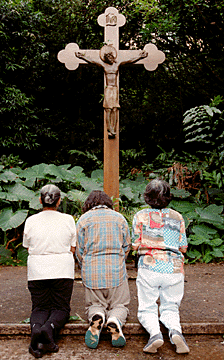


Good Friday rites mark
the good—and the grimBy Mary Adamski
Labyrinth reveals the way
Star-BulletinChristians who never go to church are likely to head there on Easter Sunday for the triumphant climax of the Gospel story, the soaring music, the flowers, the communal expression of joy, and the secular sideshow of the egg hunt.
But first there's the grim story of Christ's crucifixion, which is beingmarked today in solemn and subdued Good Friday services in Christian churches. A lot of Christians avoid it and non-Christians misunderstand it.
"A lot of people want the 'highs' but are not willing to explore the depths," said the Rev. Herman Gomes, a theology instructor at Chaminade University. "In the pain and sorrow is the depth, the depth that is our growth in our faith.
"It's kind of a yuppie thing to avoid death. In the modern world, it's not a reality we confront.
"In the Christian sense, death represents separation from those we love. The other side of the coin is that we are not people without hope. What we're doing is looking death right in the face. We're saying, 'You are real, but my faith tells me turn the page, there's more to the story.'"
Replicas of the device of torturous death is the focus on Good Friday. At the Salvation Army Kauluwela Mission, people pin prayers and petitions to a large cross. Members of several Makiki and Manoa churches march with a cross through their neighborhoods. Believers venerate the cross by kneeling, touching and kissing it, "giving honor to the symbol."
A less-intense version of the veneration has been going on throughout the six weeks of Lent in Catholic and Episcopal churches. As congregations or individuals, people walk and pray along Stations of the Cross routes, a series of 14 paintings or plaques on church walls or outdoor shrines depicting steps along Christ's path from condemnation by Pilate through death and burial.
Gomes said pilgrims to Jerusalem still trace the steps along the route, which he did in 1990, but it winds through traffic, shops and tourists, amid the noise and distractions of the busy city.
The symbolic pilgrimage of today evolved as few people could actually reach Jerusalem, and the Holy Land was conquered by Muslims and closed to Christians.
By the 15th century, the "Way of the Cross" was established as part of the furnishings in European churches, sometimes in the form of fabulous sculpture or paintings. At one time there were 37 stations, which Pope Clement XII codified into 14, Gomes said.
When the priest presided at the stations at St. Ann's Church in Kaneohe on Fridays this Lent, about 80 people attended.
Although the Gospel story read remains the same, there is a modern twist to the stations. "The prayers contain more of a theme of social justice," said Gomes. "It's not enough to be pious, but prayer moves us to do something for our brothers.
"When we were kids, we gave up candy or something for Lent. Now the teaching is to give up something, but put the price in the rice bowl and at the end, share it with the needy."
Gomes said Christians don't see the cross as a morbid symbol. "We started Lent with a cross of ashes on our forehead -- ashes, the symbol of how temporary life is. We've come from that cross to this cross, which symbolizes eternity.
"Our salvation comes because of this event. This is our Passover, we pass from this life to a better life. It's suffering, death and resurrection that make up the Paschal mystery. That's why it's called Good Friday."
Labyrinth reveals the
By Mary Adamski
way for walking prayer
Star-BulletinLike the Stations of the Cross, the Labyrinth is a meditative tool that sets participants off on foot as they pray.
The pathway painted on a 30-by-30 foot canvas floor-piece at St. Andrew's Cathedral Davies Hall circles inward.
"The center is dubbed the new Jerusalem," said Honey Becker, director of the Labyrinth Project. "It's a metaphor for a spiritual journey."
The device is a replica of the one embedded in the floor of the cathedral in Chartres, France. Thousands of islanders have taken the meditative stroll since St. Andrew's brought the replica here three years.
It will be open from 1 to 5 p.m. today, and from 10 a.m. to noon and 6 to 7 p.m. on Holy Saturday tomorrow.
Becker said the labyrinth, which predates Christianity, was adopted by the Christian church in the Middle Ages. "It was a tradition to make a pilgrimage to Jerusalem. When that was impossible, the design was incorporated in some large cathedrals. It became a symbolic pilgrimage."
People walk the labyrinth silently, using their own choice of prayer or meditation. "It becomes as individual or group-oriented as you want it to be," she said. It is not used in a religious service, but has been visited or borrowed by members of several churches and organizations here.
"There is something in a walking meditation. It diffuses excess energy in a person, allows you to be more centered," Becker said.
"Walking in a penitential mode is very beneficial at this time of season. This is a wonderful way to be preparing yourself for Easter."